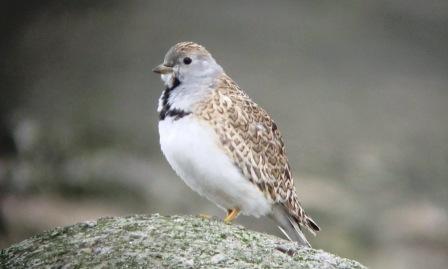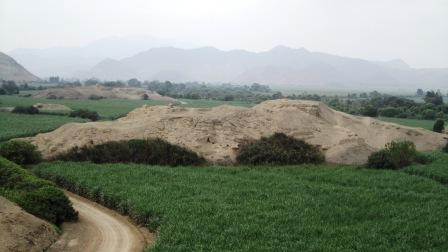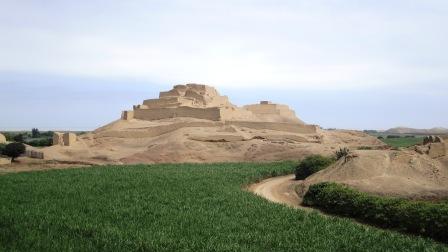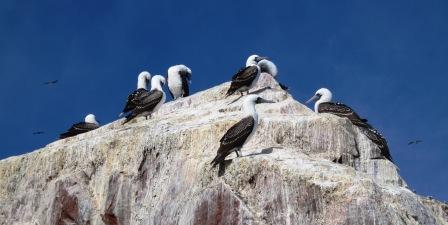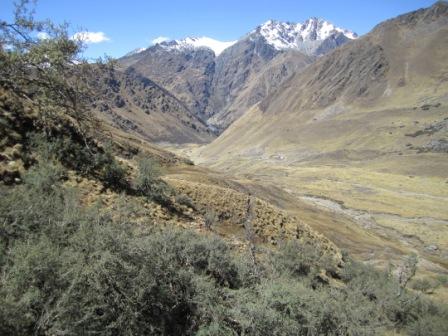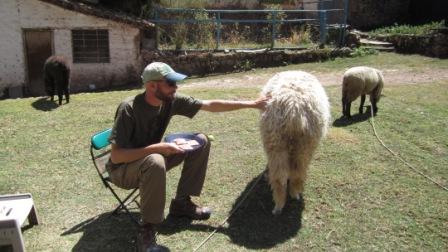calyptura.com
Jon and Anne's birding travels
Peru 2011
Central and southern Peru: desert coast to mountain forest and back again
Posted 13th September 2011
Our time in Lima wasn't all fun and games at the British Ambassadors Residence, as we had the important task of getting the vehicle serviced. The truck works so hard - up and down unpaved mountain roads gaining and losing thousands of metres at a time, hauling our little house - so we try hard to keep up with servicing. We eventually managed to find the largest Ford dealer in Lima with help from the Ambassadors driver. Our timing was good, because we needed to replace the front brakes and the drive belt (the latter was nearly sliced completely through length-wise by a small rock that had lodged in one of the pulleys, the mechanic said he had never seen such damage!). Fortunately, Anne had brought back a full set of brake pads when she visited family in April, which saved hundreds of dollars as parts are very expensive in Peru, while labour is very cheap - the opposite of a dealership service in the US of course.
Then we made our way north up the coast to various excellent birding sites, including the Lomas de Lachay, where we quickly found the local race of Cactus Canastero, limited to these few small hills, and estimated at about 20 pairs only. Also here, Least Seedsnipe (our third seedsnipe species in Peru) were at the height of their breeding activity, with males chasing each other everywhere, even running across the track in front of the vehicle. We also spent time at several estuarine areas that support impressive numbers and diversity of seabirds and waders, including the near-endemic Peruvian Tern and the stunning Inca Tern.
Male Least Seedsnipe, P.N. Lomas de Lachay, dpto. Lima, Peru, 26th July 2011
In addition to birding, we made some time for cultural exploration. Although Machu Pichu and the Nazca Lines get all of the publicity (and tourists) among archaeological sites in Peru, we came to this area north of Lima in part for the ruins of the various cities known collectively as Norte Chico. These date from 3000-2000 BC (i.e. at least 3500 years before Machu Pichu) and arguably from much earlier dates. The pyramids that were built by these early peoples in the desert country north of Lima were not as big as those built in Egypt, but they were constructed centuries earlier, and although each individual city was smaller than Sumeria, the total population and polity were as large or greater. This was undoubtedly one of the Worlds great early civilisations, but you will not find it mentioned in the history books alongside Egypt and the Fertile Crescent, presumably due to the biases of Old World perception. Anyway, we enjoyed our visit, and we had the ruins completely to ourselves the entire time.
The 4500+ year old ruins of the Fortaleza area are thankfully largely unrestored and now surrounded by maize fields (above), but some have been rather hapharzardly "rebuilt" (below).
A check of email then revealed that due to a change of plans by a visiting British government minister, our friend James the ambassador in Lima was at a loose end for the weekend, and invited us back to go birding for a day. We headed into the hills above Lima in the embassy SUV with James, his driver, and bodyguard. We found three new birds for the Ambassador, including one species new for us too.
Finally it was time to begin our exploration of the other, southern, half of Peru. We started by heading south down the coast from Lima for a boat trip out Islas Ballestas, a group of small near-shore islands that support a massive number of breeding seabirds, stopping along the way to find the endemic and unusual Peruvian Seaside Cinclodes. As you may have noticed from our photos, coastal Peru is an extremely stark and barren place - the desert literally meets the sea. Now finished with the coast, we headed back to the wilds of highland Peru.
Peruvian Boobies, Islas Ballestas, 1st August 2011
We began our return to the Andes with three days at the Santuario Nacional Ampay. This unique Podocarpus forest is so isolated that it contains several bird species found almost nowhere else, including at least one that has yet to be formally described; we found all our desired specialties here including the undescribed Ampay Tapaculo. From a sustainable ecotourism viewpoint we were actually disappointed that the super-friendly guards made no charge for us to camp two nights by the park headquarters or to enter the forest, although it was clear from the visitor logbook that almost no foreigners ever visit this unique site, hence the lack of formal entry fee.
We then did two multi-night transects along highways in the Cusco area, one for three nights in the Abra Malaga area above Ollantaytambo, and the second for nearly a week along the upper Manu road. The focus of our time in the Abra Malaga area was finding the Critically Endangered Royal Cinclodes, which is rare (perhaps fewer than 200 individuals) in wet Polylepis woodland at very high elevations (over 4,000 meters) in southern Peru and extreme north-western Bolivia. We had a very successful hike to a known site for this and several other restricted-range species, getting excellent views of the cinclodes. The site is on land inhabited by a local group of indigenous Quechua people (amazing that people live at these elevations!) who are working with a Peruvian non-profit organisation to protect the habitat. In fact, we saw the locals planting Polylepis seedlings when we were there.
The stunning scenery of the Area de Conservacion Privada Abra Malaga-Thastayoc. The Polylepis forest habitat in the foreground growing at 4300m (14,200ft) is home to one of a handful of known populations of the critically endangered Royal Cinclodes, plus other rare ultra-high elevation birds like Tawny Tit-Spinetail,White-browed Tit-Spinetail, and Ash-breasted Tit-Tyrant.
We also had a great week along the upper Manu road, enjoying the wide elevational range and a brief couple of days of warmer temperatures at the low elevation of only 1,500 meters. We had 19 new species on this excursion, including Red-and-white Antpitta, completing a clean sweep of Peru's endemic antpittas!
Back in Cusco we actually took it relatively easy (read as: lots of cleaning and travel planning) based at the classic overlander stop of Quinta Lala. This lovely spot perched just above the heart of the old city even came with abundant en suite Chestnut-breasted Mountain Finches, a Peruvian endemic species we had finally seen after considerable effort only a few days earlier! Our Norwegian friends Espen and Malin were among fellow overlanders from six countries also here at this time. They had just returned from a trip home which unfortunately coincided with the remarkable events in Oslo. It was somewhat surreal to hear of their first-hand experience of that time while we sat having tea in a campground in Peru.
Jon at Quinta Lala, Cusco,deciding which part of the alpaca he would like his next wool beanie made from. They are incredibly soft.
Fully stocked up and as clean as the vehicle had been since we were in Mexico last year, we set off to get dirty once again! First, a final try for Bearded Mountaineer. It would be an apt description of Jon, but it is actually a scarce and striking endemic hummingbird which we had already failed to find twice at Laguna Huacarpay. But third time lucky, and after an estimated total of seven-plus hours of chilly searching, we found not one but two feeding on roadside tree tobacco flowers.
Then we were on to the World's highest navigable lake, Titikaka, for its endemic grebe, and down the best road we had been on in nearly three months in Peru from Juliaca to Arequipa. We spent two cold nights above Arequipa, camped along the dirt road to Laguna Salinas, but were rewarded with some great birds, White-throated Earthcreeper being the best. Then we treated ourselves to two lovely warm days and nights in Arequipa - there is actually an old colonial-style hotel on the river right in the city that has a grassy area where they allow overlanders to camp.
Finally, we made our way back to the coast and on to the Peru-Chile border for a brief foray into northern Chile before heading into Bolivia. We both enjoyed Peru immensely and will spend more time there in the future. It is an amazing country of incredible landscapes, superb birding, and interesting cultural variety.
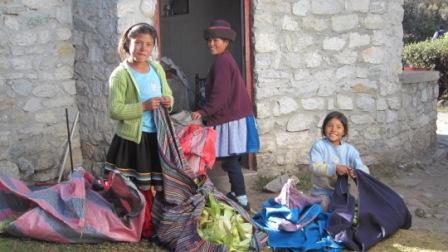
One of our favourite images from Peru. Nelida and Mayle, with their mother Ana. Ana ran a little stall at the visitor centre at the Parque Nacional Huascarn, where we were camped for a couple of nights in late June. The girls were collecting husks of corn to feed the family cuyes (guinea pigs), which are not pets in Peru, but lunch or dinner.
Lima....at last
Posted 24th July 2011
Well, yes, after six-plus weeks in Peru we finally made it to Lima. We certainly move much more slowly than our overlander friends!
You will not be able to guess where we are now. Through an unlikely series of birding-related coincidences Jon discovered an old friend of his, with whomhe travelled in Ecuador whenhe was a teenager, is now the British Ambassador to Peru! After an email exchange, James very kindly gave us an invitation to stay with him, so we wrote this in the VIP Suite at the British Ambassador's Residence in Monterrico, Lima. Hard to imagine more of a contrast from remote montane Peru, our home for more than the last month, but we are of course greatly enjoying it for a couple of days (only our third hot shower in all of Peru!). It is great to catch up with James after over 20 years, and to talk geopolitics, socioeconomics and the environment, especially given that a new (leftist leaning?) Peruvian president is due to be sworn in next week.
Bogs and lakes
Written mid July 2011
Its taken over a month since Trujillo, but we finally made our way south to the region just east of Lima by mid-July. Our destination here was an area of very high peat bogs in the midst of yet more spectacular alpine peaks and valleys. But we even outdid ourselves here, camping at 4570 meters (15,081 feet). As you would expect, it was a bit chilly overnight (-6.6 centigrade at dawn) and we woke to a very frosty landscape and frozen water bottles. It could have been worse though, because at least this is the dry season, so precipitation is rare, and there is a lot of potent sunshine once it from behind the mountains.
Of course we visited this area because it supports a very unique assemblage of species, including the critically endangered White-bellied Cinclodes. The official estimate for its population is 50-249 individuals, although the actual population is probably at the lower end of this range, and the cinclodes is found only at six sites. Unfortunately the prospects for this and other bog-dependent species are bleak. Although the human populations are understandably small in these areas, there are major environmental threats, including very intense grazing pressure from sheep, horses, llamas, and alpacas, massive mining exploitation with the inevitable accompanying contamination, and extraction of peat for mushroom growing and garden centers in Lima.
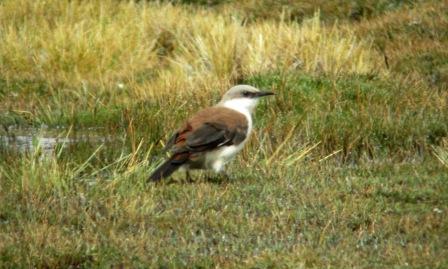
White-bellied Cinclodes, Milloc Bog, dpto. Lima
This highlights one of our strongest impressions of Peru so far, which is the contrast between the scenic beauty and biological diversity of the country on one hand, and the substantial environmental degradation on the other. We keep wondering where the people get their water from, because the creeks and rivers downstream from the mines are obviously not fit for human use and in some cases, the river beds have literally been completely filled with mine tailings. We discovered that a small Andean city we drove through (La Oroya) had been rated one of the ten most polluted cities in the World, due to contamination from the lead and copper smelter on the river bank.
We had more discussions along these lines with park service staff when we took a morning boat trip onto Chinchaycocha, known as Lake Junin, to see the (also critically endangered) Junin Grebe. A flightless waterbird found only on this 4100m-high lake, the current population estimate of 270 individuals represents a huge decline from probable thousands as recently as fifty years ago. Our continued luck with Peruvian weather gave us an ideal day for the lake, as warm as it could have been, and the huge lake as flat as a millpond. Way out near the middle we watched one pair of grebes interacting, feeding, vocalising, and even displaying, under perfect viewing conditions for over thirty minutes, which was a wonderful experience.

Junin Grebe, Chinchaycocha, dpto Junin, 18th July 2011
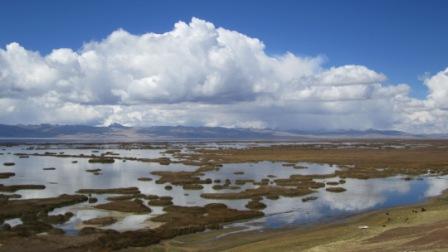
The beautiful Chinchaycocha (Lake Junin). Although the grebes nest in the lakeside vegetation, they spendmost ofthe year way out in the middle of the open water, hence a trip by zodiac boat is the only option to see them.
Satipo: the challenges of birding/driving in Peru
Written 20th July 2011
About a week ago, we headed up a famous birding road that goes toward Satipo and had a seemingly endless challenge with access. We started up the road early one morning, thinking we could get to good birding habitat by about lunchtime. But by 0800 we were stopped by a road crew saying we couldnt pass through the closure until 1800! So, we spent almost 10 hours waiting by a nearby lake at over 4000m. Having been let through the closure area a bit early we were happily on our way, planning to look for a roadside campsite after we got past the first pueblo. But as we tried to exit town on the far side, there was yet another road block and a guy saying an excavator had gone over and was blocking the road (were talking about single-lane dirt roads that cut across steep mountainsides). He explained some sort of complicated detour that we had no faith in being able to follow. It was almost dark by now and we never drive at night, but when we saw a minivan heading down the supposed detour route we figured wed better follow. The result was a tortuous two-hour drive down into a river canyon and back up again, rejoining our original road less than 15 miles further along.
The worst part was when we met oncoming traffic doing the detour from the other direction. Because the road is so narrow, at one point an oncoming vehicle had to back up for about half a mile before finding enough room to pull off and let our convoy pass. The most amusing point was when we came to a sudden unexplained halt behind several other waiting vehicles. When we got out to investigate, we discovered a truck coming the other direction was changing a flat tire in the middle of the road, blocking traffic in both directions. Great stuff.
We were lucky to find a nice wide pullout after rejoining the road and get a good nights sleep because there was more to come the next day. We made our way up and over another high pass and on to our targeted birding area in the morning. Fortunately, we found the species we were looking for, which made it all seem worth the effort, including Millpo Tapaculo (a species not yet officially described to science), but the highlight was the superb Eye-ringed Thistletail.
Our goal was to get back to the original road closure by late afternoon so we were ready in convoy when the road opened, but just after getting up and over the near pass, we met another closure. It was just after noon and the projected opening time was 1600. At least we made many friends with our fellow travelers stranded in two buses. Predictably, they had problems with the work and didnt open until 1630, after which we still had a three-hour drive to get back to and through the original closure, so we didnt get caught on the wrong side of that again in the morning. More driving in the dark on already dangerous roads, but somehow we managed to survive (at least for now).
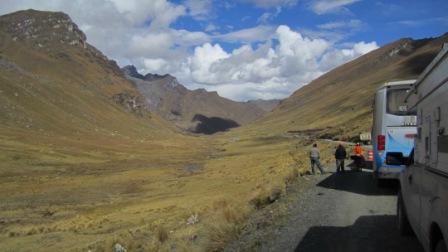
Satipo Road, 15th July 2011. There are many less scenic places to have to wait out a few hours of road construction delays!
Bosque Unchog
Written 10th July 2011
We are in Huanuco, Peru,in the eastern Andes, some 400km NNE of Lima. We actually treated ourselves to a lavish hotel room ($20!), much deserved after 12 days without a shower. (But plenty of washing in ice coldmountain rivers and streams of course.) We cut across to this area on a little used, but now thankfully largely paved, road from the Cordillera Blanca, which nevertheless required a couple of descents and climbs of 2000+m each: this has become a routine feature of vehicle travel in Peru.
We have just descended from a nearby mountain forest site called Bosque Unchog. This was probably the worst road we have had to tackle anywhere in Latin America so far. The dirt road zigzagging up the mountain to the remote pueblo of Cochabamba was slow but okay,but the last 9km from there to the mountain pass where we camped took nearly an hour. Actually it took much longer on the way up as some large boulders from a landslide in the "road" blocked our progress , so we left the vehicle there and walked on as we knew the birding was within 2-3kms. Some locals got the hint and saw a money-making opportunity, and for a small "donation", they somehow cleared the rocksthat afternoon.
Camping at 3600m this time, but it was well worth it, as we had unusually reasonable weather for this area and elevation - it barely rained - and all of our target birds, several of which are endemic to a tiny area of Peru and can be seen almost nowhere else. This included the stunning Golden-backed Mountain Tanager, which was the last of all the mountain tanagers for us, generally considered to be one of South America's finest bird groups. Plus we had two other unique tanagers here, Pardusco and Rufous-browed Hemispingus. All three of these species were first discovered in this same forest, as recently as the 1970s. Other highlights included many views of Bay-vented Cotingas, and one superb look at the rare Large-footed Tapaculo.
Northernmost Peru
Written 27th June 2011
Our time in Peru is off to a wonderful start with a very enjoyable three weeks in the north of the country. It wasnt exactly an auspicious start at the very beginning, though, due to a minor miscalculation we happened to cross the border on the day of the presidential run-off election. We were aware the election was upcoming but had no idea it was that day. This wouldnt necessarily have been a problem, except that we were at a relatively minor crossing and the only person able to issue the vehicle permit had gone to the nearest city (two hours away) to vote. So, after a few hours we were finally on our way. At least Jon filled the time with birding around the border crossing and finding yet another new hummingbird. And we amused ourselves watching the Peruvian border guards taking small tips to let locals through in both directions without paperwork.
Since then we have seen many great birds and lots of spectacular scenery, including some of the most stark desert country and impressive mountains and canyons either of us has experienced as we traversed the Andes from the coast to the Eastern slope and back again. Much of our travel was on a remote single-lane dirt road that climbs an eastern flank of the Peruvian Andes before a challenging 2500 meter descent into and ascent out of the Maraon Valley - definitely not for the faint of heart or those prone to vertigo.
There have been many excellent endemic and near-endemic Peruvian birds already. Some of the highlights include White-winged Guan, Marvelous Spatuletail, Tumbes Tyrant, Peruvian Plantcutter, Great Spinetail, and three species of inca finch. The Antpitta Express rolls on, with a stunning seven new antpittas in the past ten days or so - a complete clean up of all northern Peru's antpittas - and we got recordings of six of them.
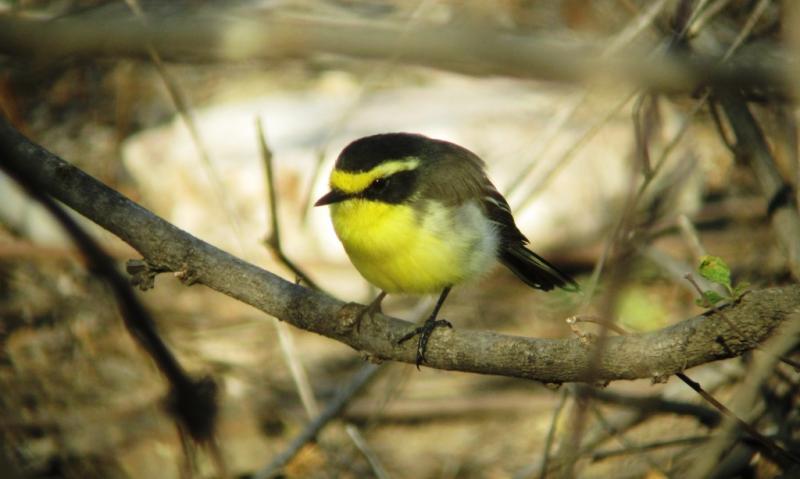
Tumbes Tyrant, 8th June 2011, El Tocto, Lambayeque, Peru
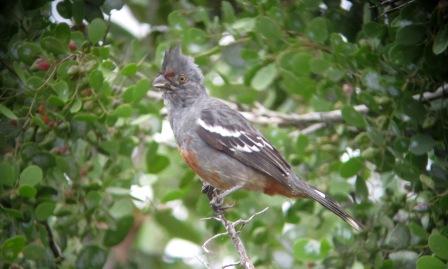
Peruvian Plantcutter, 9th June 2011, Nuevo Mocupe, Lambayeque, Peru
We were definitely surprised when we ended this first leg by rolling into a hostal in Huanchaco on the coast just north of Trujillo to find we would be sharing it with five other sets of people driving through Latin America. It was as many fellow overland travelers in one place as we had encountered in our whole 15 months of travel up to this point...and during our three-day stay, two other groups have arrived! It is a European-dominated group, with three groups of Swiss (two couples and a family with three small girls), two German couples, one Norwegian couple, and one English couple (on motorcyles). Although we enjoy our solitude and remote places, it has been nice to share stories and generally brush up on our social skills, which are somewhat lacking even at the best of times.
Image copyright notice
All images on this website are subject to copyright (© Jon King, unless otherwise stated). If you wish to use them, whether commercially or non-commercially, please inform Jon by email.
Images appearing on calyptura.com can be used free of charge by individuals and non-profit organisations for strictly non-commercial use. They can be linked or copied to other websites, or downloaded to personal computers. The only exception to this policy concerns non-commercial use of images by any individual or organisation promoting trade in captive birds, or any other activity deemed detrimental to wild birds and their habitats. This use is not permitted.
All other commercial use of images is unauthorized. If you would like to use images for any commercial purpose (i.e. publication in books, magazines, commercial websites, advertisements etc.), or if you are seeking higher resolution scans, slide duplicates or prints, please contact Jon by email.
Jon and Anne's birding travels
